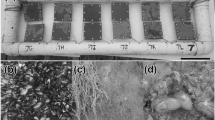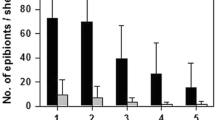Abstract
Primary fatty acid amides are commonly found in grasses, microalgae, and animal. Oleamide and erucamide are fatty acid amide derivatives of oleic and brassidic acids, respectively. They are the most frequently used slip agents in industrial applications. We evaluated their potential application as antifouling coatings on submerged surfaces. The deterrent properties of parafilm wax plates containing oleamide and erucamide against the surface recruitment of diatoms and biofilms and the attachment strength of abalones were assessed. Both amides were effective, but oleamide had 1.4-2.5-fold greater deterrent effects against all three groups of foulers. The amides produced slippery surfaces to which the biofoulers attached weakly. The benthic organisms were readily dislodged by water motion. Thus, oleamide has potential as an ingredient in antifoulant coating materials. We also developed a rapid abalone detachment assay that can be used to test the efficacy of antifouling agents against slow-growing members of the macrobenthos.
Similar content being viewed by others
References
Yebra, D. M., Kiil, S. & Dam-Johansen, K. Antifouling technology-past, present and future steps towards efficient and environmentally friendly antifouling coatings. Prog. Org. Coat. 50, 75–104 (2004).
Hall, L. W. & Pinkney, A. E. Acute and sublethal affects of organotin compounds on aquatic biota: An interpretative literature evaluation. CRC Crit. Rev. Toxicol. 14, 159–209 (1985).
Fletcher, L. R. & Callow, E. M. The settlement, attachment and establishment of marine algal spores. Brit. Phycol. J. 27, 303–329 (1992).
Chaudhury, K. M., Finlay, J., Chung, Y. J., Callow, E. M. & Callow, A. J. The influence of elastic modulus and thickness on the release of the soft-fouling green alga Ulva linza (syn Enteromorpha linza) from poly dimethylsiloxane (PDMS) model networks. Biofouling 21, 41–48 (2005).
Cho, J. Y. Antifouling activity of giffinisterone B and oleamide isolated from a filamentous bacterium Leucothrix mucor culture against Ulva pertusa. Kor. J. Fish. Aquat. Sci. 45, 30–34 (2012).
Kang, J.-Y. et al. Antifouling effects of the periostracum on algal spore settlement in the mussel Mytilus edulis. Fish. Aquat. Sci. 19, 34–39 (2016).
Garrido-López, Á., Esquiu, V. & Tena, M. T. Determination of oleamide and erucamide in polyethylene films by pressurised fluid extraction and gas chromatography. J. Chromatogr. A 1124, 51–56 (2006).
Mansha, M., Gauthier, C., Gerard, P. & Schirrer, R. The effect of plasticization by fatty acid amides on the scratch resistance of PMMA. Wear 271, 671–679 (2011).
de Zoete, M. C., Kock-van Dalen, A. C., van Rantwijk, F. & Sheldon, R. A. Lipase-catalysed ammoniolysis of lipids. A facile synthesis of fatty acid amides. J. Mol. Catalysis B: Enzymatic 1, 109–113 (1996).
Fowler, C. J., Jonsson, K.-O. & Tiger, G. Fatty acid amide hydrolase: biochemistry, pharmacology, and therapeutic possibilities for an enzyme hydrolyzing anandamide, 2-arachidonoylglycerol, palmitoylethanolamide, and oleamide. Biochem. Pharmacol. 62, 517–526 (2001).
Dembitsky, V. M., Shkrob, I. & Rozentsvet, O. A. Fatty acid amides from freshwater green alga Rhizoclonium hieroglyphicum. Phytochemistry 54, 965–967 (2000).
Cravatt, F. B. et al. Chemical characterization of a family of brain lipids that induce sleep. Science 268, 1506–1509 (1995).
Visek, K. E. in Surfactant Science Series, Vol. 34 (ed Richmond, J. M.) 1-50 (Marcel Dekker, New York, 1990).
Huitrón-Reséndiz, S., Gombart, L., Cravatt, B. F. & Henriksen, S. J. Effect of oleamide on sleep and its relationship to blood pressure, body temperature, and locomotor activity in rats. Exp. Neurol. 172, 235–243 (2001).
Ge, L. et al. Differential proteomic analysis of the antidepressive effects of oleamide in a rat chronic mild stress model of depression. Pharmacol. Biochem. Be. 131, 77–86 (2015).
Hopps, J. J., Dunn, W. R. & Randall, M. D. Enhanced vasorelaxant effects of the endocannabinoid-like mediator, oleamide, in hypertension. Eur. J. Pharmacol. 684, 102–107 (2012).
Oh, Y. T. et al. Oleamide suppresses lipopolysaccharideinduced expression of iNOS and COX-2 through inhibition of NF-kB activation in BV2 murine microglial cells. Neurosci. Lett. 474, 148–153 (2010).
Wei, X. Y., Yang, J. Y., Dong, Y. X. & Wu, C. F. Anxiolytic-like effects of oleamide in group-housed and socially isolated mice. Prog. Neuro-Psychoph. 31, 1189–1195 (2007).
Dougalis, A., Lees, G. & Ganellin, C. R. The sleep lipid oleamide may represent an endogenous anticonvulsant: an in vitro comparative study in the 4-aminopyridine rat brain-slice model. Neuropharmacology 46, 541–554 (2004).
Mendelson, W. B. & Basile, A. S. The hypnotic actions of the fatty acid amide, oleamide. Neuropsychopharmacology 25, S36–S39 (2001).
Yang, J.-Y., Abe, K., Xu, N.-J., Matsuki, N. & Wu, C.-F. Oleamide attenuates apoptotic death in cultured rat cerebellar granule neurons. Neurosci. Lett. 328, 165–169 (2002).
Wakamatsu, K., Masaki, T., Itoh, F., Kondo, K. & Sudo, K. Isolation of fatty acid amide as an angiogenic principle from bovine mesentery. Biochem. Biophys. Res. Commun. 168, 423–429 (1990).
Hamberger, A. & Stenhagen, G. Erucamide as a modulator of water balance: new function of a fatty acid amide. Neurochem. Res. 28, 177–185 (2003).
Madaeni, S. S., Falsafi, M. & Ghaemi, N. A novel method for preparation of low-fouling membranes: Surface coating by extracted wax from leafy cabbage. Desalination 283, 148–155 (2011).
Hoipkemeier-Wilson, L. et al. Antifouling potential of lubricious, micro-engineered, PDMS elastomers against zoospores of the green fouling alga Ulva (Enteromorpha). Biofouling 20, 53–63 (2004).
Bowen, J. et al. The influence of surface lubricity on the adhesion of Navicula perminuta and Ulva linza to alkanethiol self-assembled monolayers. J. Roy. Soc. Interface 4, 473–477 (2007).
Lin, A. Y. M., Brunner, R., Chen, P. Y., Talke, F. E. & Meyers, M. A. Underwater adhesion of abalone: The role of van der Waals and capillary forces. Acta Mater. 57, 4178–4185 (2009).
Bertin, M. J., Zimba, P. V., Beauchesne, K. R., Huncik, K. M. & Moeller, P. D. R. Identification of toxic fatty acid amides isolated from the harmful alga Prymnesium parvum carter. Harmful Algae 20, 111–116 (2012).
Shao, J. et al. Growth inhibition and possible mechanism of oleamide against the toxin-producing cyanobacterium Microcystis aeruginosa NIES-843. Ecotoxicology 25, 225–233 (2016).
Greene, G. W. et al. Lubricin: A versatile, biological anti-adhesive with properties comparable to polyethylene glycol. Biomaterials 53, 127–136 (2015).
Heo, J. et al. Improved performance of protected catecholic polysiloxanes for bioinspired wet adhesion to surface oxides. J. Am. Chem. Soc. 134, 20139–20145 (2012).
Lee, H., Scherer, N. F. & Messersmith, P. B. Singlemolecule mechanics of mussel adhesion. Proc. Nat. Acad. Sci., USA 103, 12999–13003 (2006).
Guillard, R. R. & Ryther, H. J. Studies of marine planktonic diatoms. I. Cyclotella nana Hustedt and Detonula confervacea (Cleve) Gran. Can. J. Microbiol. 8, 229–239 (1962).
Subramanyam, E., Mohandoss, S. & Shin, W. H. Synthesis, characterization, and evaluation of antifouling polymers of 4-acryloyloxybenzaldehyde with methyl methacrylate. J. Appl. Poly. Sci. 112, 2741–2749 (2009).
Provasoli L. in Cultures and Collections of Algae (eds Watanabe, A. & Hattori, A.) 63–79 (The Japanese Society of Plant Physiologists, Tokyo, 1968).
Kochert G. in Handbook of Phycological Methods, Vol. 2 (eds Hellebust, A. J. & Craigie, S. J.) 95–97 (Cambridge University Press, Cambridge, 1978).
Author information
Authors and Affiliations
Corresponding author
Rights and permissions
About this article
Cite this article
Getachew, P., Getachew, M., Joo, J. et al. The slip agents oleamide and erucamide reduce biofouling by marine benthic organisms (diatoms, biofilms and abalones). Toxicol. Environ. Health Sci. 8, 341–348 (2016). https://doi.org/10.1007/s13530-016-0295-8
Received:
Revised:
Accepted:
Published:
Issue Date:
DOI: https://doi.org/10.1007/s13530-016-0295-8




